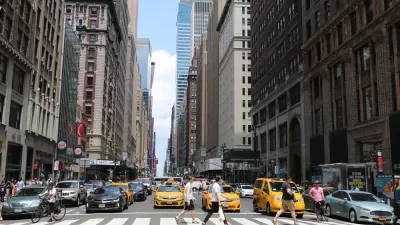A strong scent of snark is detected in a recent editorial criticizing the possibility of building a shared bike and pedestrian path on the Verrazano-Narrows Bridge to State Island.
The State Island Advance editorial board voices its displeasure with the escalating cost of a plan to build a bicycle and pedestrian path across the Verrazano-Narrows Bridge. At issue is a recent cost estimate in the ballpark of $300 to $400 million.
The editorial takes a few swipes at the bicycle lobby, who "think the MTA should spare no expense to build a bike path across the Narrows." But the editorial claims that compared to put bikepaths on streets throughout the boroughs, putting a bike and pedestrian path on the bridge is a much taller order:
"One of the ideas under consideration is the construction of bike and pedestrian lanes on either side of the deck on the lower level. A second proposal offers the same configuration on the upper level. And then there's a proposal to build a separate bridge that would run parallel to the Verrazano. The second span would be equipped with a vertical lift in its center to allow ships to pass."
The editorial board makes it clear that they consider any such plans to be a joke, albeit an expensive one. The new price tag of $300 to $400 million has climbed from its original estimate of $75 million, to be sure. Instead of spending the money on the new path, the editorial proposes that the community deserves better transit options first, and should join the editorial board in voicing its displeasure with the project.
FULL STORY: $300-$400 million for Verrazano bike paths? Are they nuts? (editorial)

Planetizen Federal Action Tracker
A weekly monitor of how Trump’s orders and actions are impacting planners and planning in America.

Chicago’s Ghost Rails
Just beneath the surface of the modern city lie the remnants of its expansive early 20th-century streetcar system.

San Antonio and Austin are Fusing Into one Massive Megaregion
The region spanning the two central Texas cities is growing fast, posing challenges for local infrastructure and water supplies.

Since Zion's Shuttles Went Electric “The Smog is Gone”
Visitors to Zion National Park can enjoy the canyon via the nation’s first fully electric park shuttle system.

Trump Distributing DOT Safety Funds at 1/10 Rate of Biden
Funds for Safe Streets and other transportation safety and equity programs are being held up by administrative reviews and conflicts with the Trump administration’s priorities.

German Cities Subsidize Taxis for Women Amid Wave of Violence
Free or low-cost taxi rides can help women navigate cities more safely, but critics say the programs don't address the root causes of violence against women.
Urban Design for Planners 1: Software Tools
This six-course series explores essential urban design concepts using open source software and equips planners with the tools they need to participate fully in the urban design process.
Planning for Universal Design
Learn the tools for implementing Universal Design in planning regulations.
planning NEXT
Appalachian Highlands Housing Partners
Mpact (founded as Rail~Volution)
City of Camden Redevelopment Agency
City of Astoria
City of Portland
City of Laramie




























